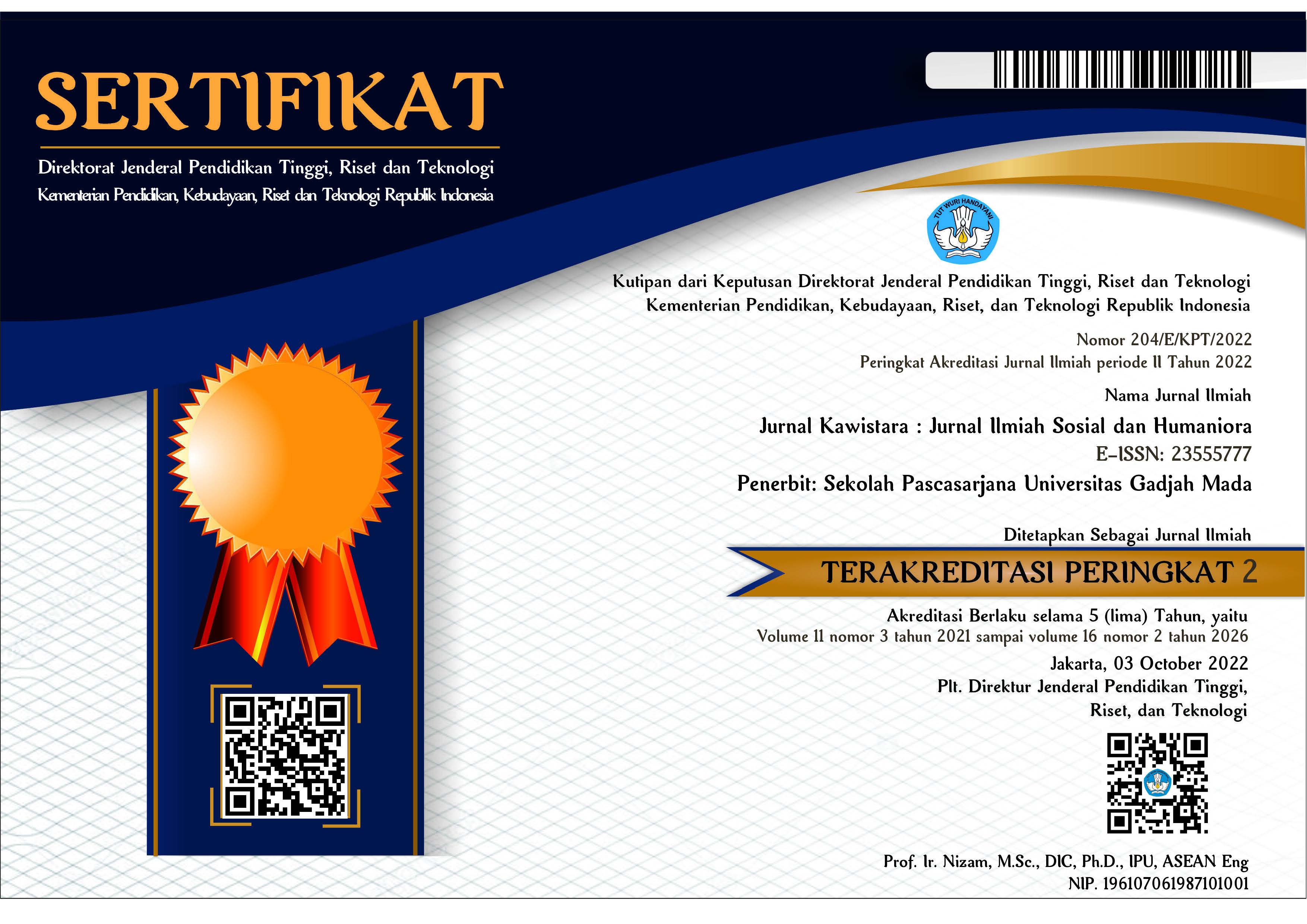Spatial Utilization for the Skills Development Program in Yogyakarta Class IIB Correctional Facility for Women
Mutiara Anggi(1*), Diananta Pramitasari(2)
(1) Universitas Gadjah Mada
(2) Universitas Gadjah Mada
(*) Corresponding Author
Abstract
A correctional facility has been considered critical not only in accommodating prisoners but also facilitating vocational training that prepares the prisoners to reintegrate in society and thus would not recommit crimes. However, in reality the building of many correctional facilities are not prepared for this function. This is apparent in the correctional facility for women in Yogyakarta. The facility does not have its official building and is located in the men’s correctional facility. Those conditions impact the spatial limitations, including space to conduct the skills development program. This study aims to examine the spatial utilization for the skills development program in Yogyakarta prison for women by analyzing the relationship between the physical settings and the occurring activities there. By conducting place-centered mapping, questionnaire survey, and interview for data collection, this study showed that prisoners tend to seek to carry the vocational work in comfortable areas provided with better air condition that are not prepared for the training. This finding raises a concern about how a correctional facility should have adequate space that encourages social solidarity and provides enough spatial autonomy for the skills development program.
Keywords
Full Text:
PDFReferences
Behan, C. (2014). Learning to Escape: Prison Education, Rehabilitation and the Potential for Transformation. Journal of Prison Education and Reentry, 1(1): 20-31. DOI: 10.15845/jper.v1i1.594.
Bell, P.A., Greene, T.C., Fisher, J.D., and Baum, A. (2001). Environmental Psychology. Fort Worth, TX: Harcourt College Publishers.
Brottveit, G. Catucci, S., D’Onofrio, R., Fagnoni, P.M., Fransson, E., Fridhov, I.M., … and Trusiani, E. (2018). Prison, Architecture and Humans. Norwegia: Cappelen Damm Akademisk. DOI: 10.1177/000271623115700106.
Christie, N. (1982). How Closely Knit a Society. Oslo: Universitetsforlaget.
Crewe, B., Liebling, A., and Hulley, S. (2015). Staff‐prisoner Relationships, Staff Professionalism, and the Use of Authority in Public‐and Private‐Sector Prisons. Law and Social Inquiry, 40(2): 309–344. DOI: 10.1111/lsi.12093.
Cullen, F. and Gendreau, P. (2000). Assessing Correctional Rehabilitation: Policy, Practice, and Prospects. Criminal Justice, 3(1): 299–370.
Desiyana, I. (2017). Kuasa dan Kontrol Arsitektur Penjara pada Persepsi Ruang dan Perilaku Remaja Pria: Studi Kasus Lembaga Pemasyarakatan Anak Pria, Tangerang. Ultimart: Jurnal Komunikasi Visual, 10(2): 33-46. DOI: 10.31937/ultimart.v10i2.771.
Giddens, A. (1990). The Consequences of Modernity. Stanford: Stanford University Press.
Giddens, A. (1991). Modernity and Self-Identity: Self and Society in Late Modern Age. Stanford: Stanford University Press.
van Ginneken, E.F.J.C., Palmen, H., Bosma, A.Q., Nieuwbeerta, P., and Berghuis, M.L. (2018). The Life in Custody Study: The Quality of Prison Life in Dutch Prison Regimes. Journal of Criminological Research, Policy and Practice, 4(4): 253–268. DOI: 10.1108/JCRPP-07-2018-0020.
Glass, D.C. and Singer, J.E. (1972). Urban Stress. New York: Academic Press.
Gonçalves, L.C. Gonçalves, R.A., Martins, C., Braga, T., Ferreira, C., Lindegaard, M.R., and Dirkzwager, A.J.E. (2015). Prisoners’ Coping Strategies in Portugal. In Reeves, C. (Ed.). Experiencing Imprisonment: Research on the Experience of Living and Working in Carceral Institutions. London: Routledge.
Jewkes, Y. (2018). Just Design: Healthy Prisons and the Architecture of Hope. Australian and New Zealand Journal of Criminology, 51(3): 319–338. DOI: 10.1177/0004865818766768.
John, V.J.S., Blount-Hill, K., Evans, D., Ayers, D., and Allard, S. (2019). Architecture and Correctional Services: A Facilities Approach to Treatment. The Prison Journal, 99(6): 748–770. DOI: 10.1177/0032885519877402.
Johnsen, B., Granheim, P.K., and Helgesen, J. (2011). Exceptional Prison Conditions and the Quality of Prison Life: Prison Size and Prison Culture in Norwegian Closed Prisons. European Journal of Criminology, 8(6): 515–529. DOI: 10.1177/1477370811413819.
Law of the Republic of Indonesia No. 12 of 1995 on Correctional Facility. December 30, 1995. State Gazette of Republic of Indonesia No. 77 of 1995. Jakarta.
Liebling, A. (2011). Distinctions and Distinctiveness in the Work of Prison Officers: Legitimacy and Authority Revisited. European Journal of Criminology, 8(6): 484–499. DOI: 10.1177/1477370811413807.
Liebling, A. and Arnold, H. (2004). Prisons and Their Moral Performance: A Study of Values, Quality and Prison Life. Oxford: Oxford University Press.
Martel, J. (2006). To be, One Has to be Somewhere: Spatio-temporality in Prison Segregation. The British Journal of Criminology, 46(4): 587-612. DOI: 10.1093/bjc/azl012.
Maryani, D. (2015). Faktor-faktor Penyebab Tidak Tercapainya Tujuan Pemidanaan Lembaga Pemasyarakatan di Indonesia. Jurnal Hukum Sehasen, 1(1).
Ministerial of Justice and Human Rights Decree of 2003 on Building Model of Correctional Facility. April 10, 2003. No. M.01.PL.01.01 of 2003. Jakarta.
Ministerial of Justice Decree of 1990 on Model of Prisoners Development. No. M. 02-PK.04.10 of 1990. April 10, 1990. Jakarta.
Molleman, T. and Leeuw, F.L. (2012). The Influence of Prison Staff on Inmate Conditions: A Multilevel Approach to Staff and Inmate Surveys. European Journal on Criminal Policy and Research, 18(2): 217–233. DOI: 10.1007/s10610-011-9158-7.
Moore, E. (1985). Environmental Variable Affecting Prisoner Healthcare Demands. Proceedings of the American Institute of Architects. Los Angeles.
Rachmayani, K.A.U. (2018). Hubungan Penyesuaian Diri dengan Stres pada Narapidana Wanita di Lembaga Pemasyarakatan Perempuan Kelas IIB Yogyakarta. Undergraduate Thesis, Yogyakarta: Undergraduate Program of Nursing Science Universitas Gadjah Mada.
Sparks, R., Bottoms, A.E., and Hay, W. (1996). Prisons and the Problem of Order. Oxford: Clarendon Press.
Sykes, G.M. (1958). The Society of Captives: A Study of a Maximum Security Prison. Princeton, NJ: Princeton University Press.
Wells, M., Thelen, L., and Ruark, J. (2007). Workspace Personalization and Organisational Culture: Does Your Work Space Reflect You or Your Company? Environment and Behavior, 39: 616–634. DOI: 10.1177/0013916506295602.
Yang, S., Kadouri, A., Révah-Lévy, A., Mulvey, E.P., and Falissard, B. (2009). Doing Time: A Qualitative Study of Long-Term Incarceration and the Impact of Mental Illness. International Journal of Law and Psychiatry, 32(5): 294–303. DOI: 10.1016/j.ijlp.2009.06.003.
Article Metrics
Refbacks
- There are currently no refbacks.
Copyright (c) 2021 Mutiara Anggi, Diananta Pramitasari

This work is licensed under a Creative Commons Attribution-ShareAlike 4.0 International License.
Jurnal Kawistara is published by the Graduate School, Universitas Gadjah Mada.








